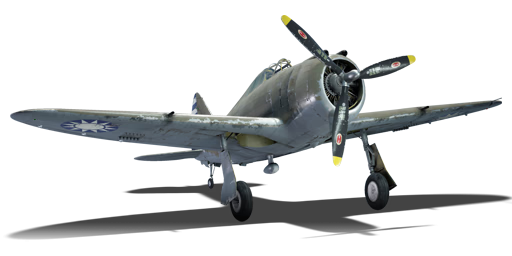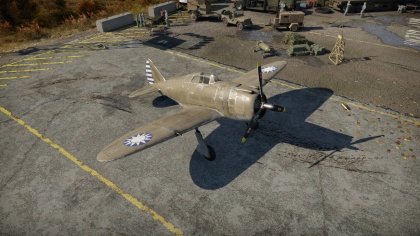Difference between revisions of "P-43A-1 (China)"
(Edits) |
(→General info) |
||
| Line 16: | Line 16: | ||
<!-- ''Describe how the aircraft behaves in the air. Speed, manoeuvrability, acceleration and allowable loads - these are the most important characteristics of the vehicle.'' --> | <!-- ''Describe how the aircraft behaves in the air. Speed, manoeuvrability, acceleration and allowable loads - these are the most important characteristics of the vehicle.'' --> | ||
| − | The P-43 | + | The P-43 was started as a private venture by the Seversky Aircraft Company (later known as Republic) which sought to improve upon its earlier fighter design the P-35. Several design changes turned this fighter into a good platform of which made the leap to the younger sibling, the P-47. The P-43 in its own right during 1940 when introduced to the United States Army Air Corps (USAAC) was the only fighter which excelled at high-altitude performance due to its belly-mounted turbo-supercharger and an effective oxygen system to sustain the pilot at those heights. |
| + | |||
| + | Much like its predecessor and successor, the P-43 is a heavy fighter with a large engine which fills the role of a fighter/interceptor. Japanese aircraft at this rank can still outturn the P-43, but if used properly as a Boom & Zoom fighter, there should not be any need to turn fight. Priorities are to gain altitude and then be selective of the targets. Use diving speeds to zip in, shoot the enemy aircraft and then pull up and climb away. Resist the temptation of immediately turning back and finishing off an aircraft which was missed or wounded as doing so will only cause the P-43 to bleed energy it needs to work at its optimum. As a last resort, if caught in a situation where you need to dogfight, do so, but look for a way out so that you don't become easy pickings for another enemy pilot. | ||
{| class="wikitable" style="text-align:center" width="70%" | {| class="wikitable" style="text-align:center" width="70%" | ||
Revision as of 22:31, 6 May 2020
Contents
| This page is about the Chinese fighter P-43A-1 (China). For American version, see P-43A-1. |
Description
The ␗P-43A-1 is a rank II Chinese fighter
with a battle rating of 3.0 (AB) and 2.7 (RB/SB). It was introduced in Update 1.91 "Night Vision".
General info
Flight performance
The P-43 was started as a private venture by the Seversky Aircraft Company (later known as Republic) which sought to improve upon its earlier fighter design the P-35. Several design changes turned this fighter into a good platform of which made the leap to the younger sibling, the P-47. The P-43 in its own right during 1940 when introduced to the United States Army Air Corps (USAAC) was the only fighter which excelled at high-altitude performance due to its belly-mounted turbo-supercharger and an effective oxygen system to sustain the pilot at those heights.
Much like its predecessor and successor, the P-43 is a heavy fighter with a large engine which fills the role of a fighter/interceptor. Japanese aircraft at this rank can still outturn the P-43, but if used properly as a Boom & Zoom fighter, there should not be any need to turn fight. Priorities are to gain altitude and then be selective of the targets. Use diving speeds to zip in, shoot the enemy aircraft and then pull up and climb away. Resist the temptation of immediately turning back and finishing off an aircraft which was missed or wounded as doing so will only cause the P-43 to bleed energy it needs to work at its optimum. As a last resort, if caught in a situation where you need to dogfight, do so, but look for a way out so that you don't become easy pickings for another enemy pilot.
| Characteristics | Max Speed (km/h at 7,600 m) |
Max altitude (metres) |
Turn time (seconds) |
Rate of climb (metres/second) |
Take-off run (metres) | |||
|---|---|---|---|---|---|---|---|---|
| AB | RB | AB | RB | AB | RB | |||
| Stock | 546 | 531 | 9700 | 19.9 | 20.6 | 10.8 | 10.8 | 343 |
| Upgraded | 589 | 566 | 18.1 | 19.0 | 17.1 | 13.6 | ||
Details
| Features | ||||
|---|---|---|---|---|
| Combat flaps | Take-off flaps | Landing flaps | Air brakes | Arrestor gear |
| ✓ | ✓ | ✓ | X | X |
| Limits | ||||||
|---|---|---|---|---|---|---|
| Wings (km/h) | Gear (km/h) | Flaps (km/h) | Max Static G | |||
| Combat | Take-off | Landing | + | - | ||
| 760 | 281 | 450 | 450 | 241 | ~11 | ~8 |
| Optimal velocities | |||
|---|---|---|---|
| Ailerons (km/h) |
Rudder (km/h) |
Elevators (km/h) |
Radiator (km/h) |
| < 370 | < 400 | < 440 | > 270 |
| Compressor (RB/SB) | ||
|---|---|---|
| Setting 1 | ||
| Optimal altitude | 100% Engine power | WEP Engine power |
| 7,620 m | 1,100 hp | 1,199 hp |
Survivability and armour
Examine the survivability of the aircraft. Note how vulnerable the structure is and how secure the pilot is, whether the fuel tanks are armoured, etc. Describe the armour, if there is any, and also mention the vulnerability of other critical aircraft systems.
Armaments
Offensive armament
The P-43A-1 (China) is armed with:
- 2 x 12.7 mm M2 Browning machine guns, nose-mounted (200 rpg = 400 total)
- 2 x 12.7 mm M2 Browning machine guns, wing-mounted (200 rpg = 400 total)
Usage in battles
P-43 pilots should climb at the beginning of a match. A climb angle of about 25 degrees should work fine. Aim to reach 4000 m before leveling out and gaining speed. Generally, the Lancer will be pitted against Japanese fighters. At this BR, the most dangerous enemies will be Ki-43s, A6Ms, and Ki-61s. These fighters will easily outturn you, but your speed advantage in a dive will make up for it. Aim to be higher than these enemies. As for bombers, due to your limited ammo, do not attack unless it is absolutely necessary. To engage enemy fighters, utilise conventional Boom and Zoom attacks. If the enemy you dive on turns to evade, do not chase. Instead, pull up and dive again. Your limited ammo means trigger discipline is important - something made a bit easier by the poor armour of those enemies. Use stealth belts. 400 m convergence is recommended, and you will want to wait until you are 0.5 km away to start firing. In a good pilot's hands, a P-43 can easily take out 5 enemy aircraft. However, if abused, it is a sitting duck for the Japanese. The P-43 is a good plane for pilots looking to use the much better P-47 later on.
Manual Engine Control
| MEC elements | ||||||
|---|---|---|---|---|---|---|
| Mixer | Pitch | Radiator | Supercharger | Turbocharger | ||
| Oil | Water | Type | ||||
| Controllable | Controllable Not auto controlled |
Controllable Not auto controlled |
Controllable Not auto controlled |
Separate | Not controllable 1 gear |
Auto controlled |
Modules
| Tier | Flight performance | Survivability | Weaponry | |
|---|---|---|---|---|
| I | Fuselage repair | Radiator | Offensive 12 mm | |
| II | Compressor | Airframe | ||
| III | Wings repair | Engine | New 12 mm MGs | |
| IV | Engine injection | Cover | ||
Pros and cons
Pros:
- Decent top speed
- Respectable firepower
- Good high-speed manoeuvrability
- Good dive speed
- Mostly faces Japanese aircraft
Cons:
- Low-speed manoeuvrability is not very good
- No payload options
- Low ammo
History
Describe the history of the creation and combat usage of the aircraft in more detail than in the introduction. If the historical reference turns out to be too long, take it to a separate article, taking a link to the article about the vehicle and adding a block "/History" (example: https://wiki.warthunder.com/(Vehicle-name)/History) and add a link to it here using the main template. Be sure to reference text and sources by using <ref></ref>, as well as adding them at the end of the article with <references />. This section may also include the vehicle's dev blog entry (if applicable) and the in-game encyclopedia description (under === In-game description ===, also if applicable).
Media
Excellent additions to the article would be video guides, screenshots from the game, and photos.
See also
Links to the articles on the War Thunder Wiki that you think will be useful for the reader, for example:
- reference to the series of the aircraft;
- links to approximate analogues of other nations and research trees.
External links
Paste links to sources and external resources, such as:
- topic on the official game forum;
- encyclopedia page on the aircraft;
- other literature.
| Republic Aviation Corporation | |
|---|---|
| Fighters | P-43A-1 |
| P-47D-22-RE · P-47D-25 · P-47D-28 · P-47M-1-RE · ⋠P-47M-1-RE · P-47N-15 | |
| Jet Aircraft | F-84B-26 · F-84F · F-84G-21-RE |
| F-105D | |
| Export | J9 Early* |
| ␗P-43A-1 | |
| ▄Thunderbolt Mk.1 · ▄P-47D-22-RE · ␗P-47D-23-RA · ▂P-47D-27 · ␗P-47D-30 · ▄P-47D-30 · ␗F-47N-25-RE | |
| ◄F-84F · ▄F-84F (Italy) · ▄F-84F (France) · F-84F IAF · F-84F | |
| ␗F-84G-21-RE · ▄F-84G-21-RE · ▄F-84G-26-RE · ␗F-84G-31-RE | |
| Captured | ▀P-47D-16-RE · ▀P-47D |
| *The company was named "Seversky Aircraft Company" before being renamed in 1939 | |
| China fighters | |
|---|---|
| British | ␗Gladiator Mk I |
| French | D.510C |
| Japanese | ␗A6M2 · ␗Ki-27 otsu · ␗Ki-43-III ko · ␗Ki-44-II hei · ␗Ki-61-I otsu · ␗Ki-84 ko |
| American | CW-21 · Hawk III · P-66 · ␗P-40E-1 · H-81A-2 · ␗P-43A-1 |
| ␗P-47D-23-RA · ␗P-47D-30 · ␗F-47N-25-RE · ␗P-51C-11-NT · ␗P-51D-20 · ␗P-51K | |
| Soviet | ␗I-15bis · ␗I-153 M-62 · ␗I-16 Chung 28 · ␗I-16 type 5 · ␗I-16 type 10 · ␗I-16 type 17 · ␗La-11 · ␗La-9 |





